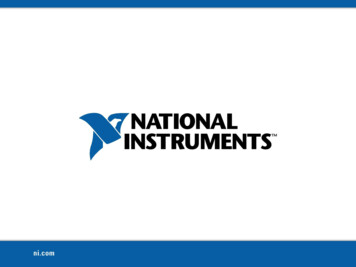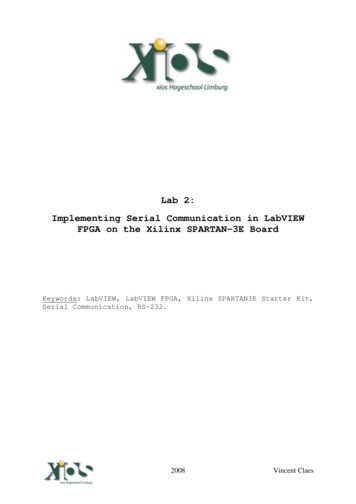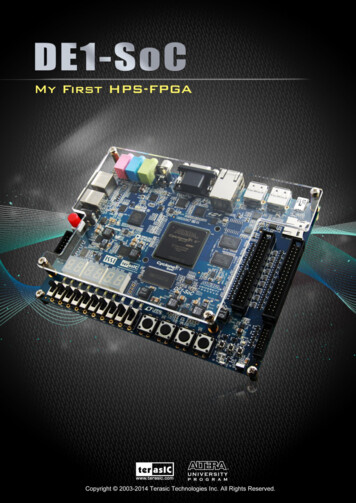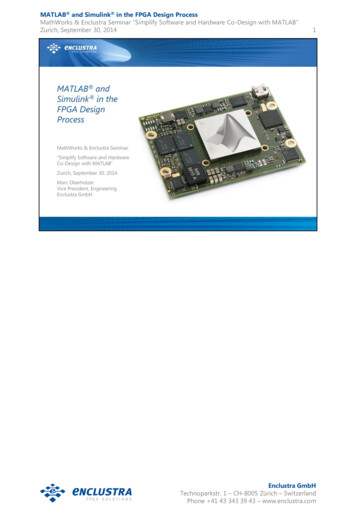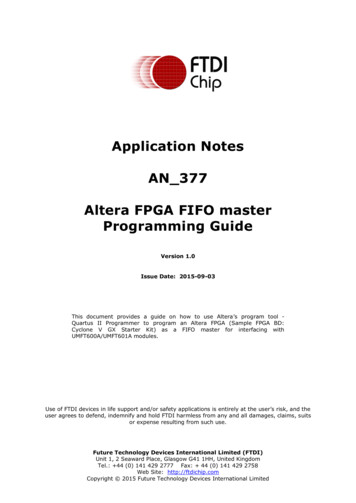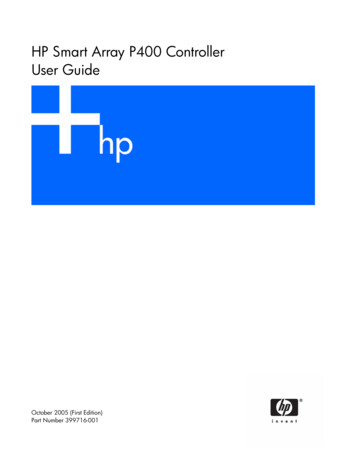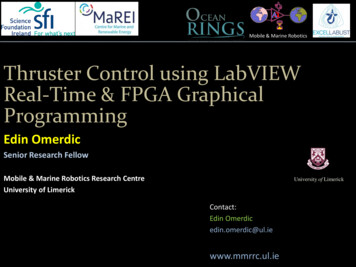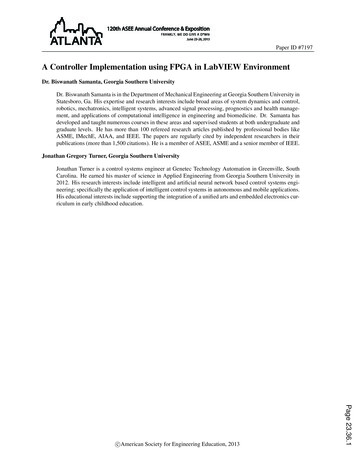
Transcription
Paper ID #7197A Controller Implementation using FPGA in LabVIEW EnvironmentDr. Biswanath Samanta, Georgia Southern UniversityDr. Biswanath Samanta is in the Department of Mechanical Engineering at Georgia Southern University inStatesboro, Ga. His expertise and research interests include broad areas of system dynamics and control,robotics, mechatronics, intelligent systems, advanced signal processing, prognostics and health management, and applications of computational intelligence in engineering and biomedicine. Dr. Samanta hasdeveloped and taught numerous courses in these areas and supervised students at both undergraduate andgraduate levels. He has more than 100 refereed research articles published by professional bodies likeASME, IMechE, AIAA, and IEEE. The papers are regularly cited by independent researchers in theirpublications (more than 1,500 citations). He is a member of ASEE, ASME and a senior member of IEEE.Jonathan Gregory Turner, Georgia Southern UniversityJonathan Turner is a control systems engineer at Genetec Technology Automation in Greenville, SouthCarolina. He earned his master of science in Applied Engineering from Georgia Southern University in2012. His research interests include intelligent and artificial neural network based control systems engineering; specifically the application of intelligent control systems in autonomous and mobile applications.His educational interests include supporting the integration of a unified arts and embedded electronics curriculum in early childhood education.Page 23.36.1c American Society for Engineering Education, 2013
A Controller Implementation using FPGA in LabVIEWEnvironmentAbstract: The paper presents a case study of introducing field programmable gate array (FPGA)based implementation of controllers in LabVIEW environment in a graduate Mechatronicscourse. The process of system identification, controller design and its implementation isillustrated using a physical system in the laboratory setting. The students’ survey response on theintroduction of FPGA based controller implementation in the course is mostly positive.I.IntroductionThere is a wide-spread interest in field programmable gate array (FPGA) based implementationof controllers in industrial applications1-5. FPGAs consist of reprogrammable gate array logiccircuits and offer flexibility, reliability, and high-speed parallel execution1,2,6,7. TraditionallyFPGA courses are offered in programs in Electrical and Computer Engineering (ECE)8-10. Tobetter prepare the engineering students in FPGA technology, especially those in control systemsarea, there is a need to introduce FPGA based devices and their applications in engineeringprograms beyond ECE. Among different options available for introduction of FPGA basedsystems in engineering courses, the reconfigurable data acquisition devices (RIO) and LabVIEWFPGA module 11,12 from National Instruments (NI) provide access to FPGA based platformswith a high level programming language support in a laboratory setting. To satisfy the need ofkeeping the program content current, FPGA based data acquisition and control systems alongwith LabVIEW from NI were introduced in a graduate Mechatronics course in the Department ofMechanical Engineering at Georgia Southern University.The paper presents the implementation of a digital controller using FPGA in LabVIEWenvironment within a graduate Mechatronics course. The rest of the paper is organized asfollows. Section II describes briefly the example system used for illustrating the process ofsystem identification, controller design and implementation. Section III discusses the procedureof experimentally identifying the system model parameters. Section IV describes the design of adigital PID controller using MATLAB13. In Section V, the implementation of the discrete-timecontroller is described using FPGA based hardware and LabVIEW software. Controllerimplementation results are presented in Section VI. Students’ survey responses are discussed inSection VII. The salient points of the work and the future scope are summarized in Conclusion.II.Example SystemPage 23.36.2A position control system was implemented for a physical system to reinforce concepts learnedin Mechatronics coursework. The controlled physical system was a rectilinear spring-massdamper system, Model M210, from Educational Control Products (ECP)14. MATLAB fromMathworks13 aided the design of a discrete-time PID controller. National instruments LabVIEWwas used to implement the control system and an FPGA based data acquisition hardware was
used to interface software controls and the physical system10,11. The physical system used forcontrol implementation is shown in Fig. 1. The model depicts a 3 degree-of freedom system inrectilinear motion consisting of 3 blocks (carts) of mass connected through 3 springs and adamper. Each cart is equipped with an optical encoder for measuring its position. The cartsystem is driven by a DC motor. An inverted pendulum unit can be attached to any of the blocksfor an additional degree of freedom and also adding as a disturbance. An optical encoder isattached to the pendulum base to measure its angular position. In the present experiment, a singledegree-of-freedom system is considered using only the first mass-spring combination.Figure 1: ECP M210 system used for position controlA National Instruments PCI-7831R reconfigurable input/output (I/O) card11 was used to interfaceoptical encoders for system position feedback and to provide a control signal. The NI PCI7831R is a multifunction, reconfigurable I/O device. The centerpiece of the data acquisition cardis a Xilinx Virtex-II FPGA. The 1 million gate FPGA is used to control the 96 configurabledigital I/O lines and allows programming of custom logic to customize the functionality of thehardware. The PCI-7831R also provides 8 analog inputs and 8 analog outputs. The analoginputs have independently configurable sampling rates up to 200 kHz, and 16-bit resolution overa maximum input voltage range of 10V. The analog outputs also have 16-bit resolution and canbe updated up to 1 million times a second. A power amplifier from ECP was used to conditionthe control signal and drive the DC motor for the cart.The objective of this lab activity was to identify the system model parameters, design a PIDcontroller in discrete-time domain for controlling the position of the cart and implement thecontroller using the FGPA based hardware in LabVIEW environment.III.System IdentificationPage 23.36.3The physical system was modeled as a second order system given by the transfer function in Eq.(1) where k is the steady state gain, ωn represents the natural frequency of the system, and ζ is the
damping ratio. The system model included the dynamic effects of the power amplifier, thesystem dynamic components and the position sensing equipment.(1) A bump test was carried out to determine the model parameters (k, ωn, and ζ). The system wasexcited using a step input of 1V to the DC motor and the cart position was recorded. The entireprocedure was carried out using the PCI-7381R FPGA based card in LabVIEW environment.The obtained system response from the collected data is shown in Fig. 2.Cart Position vs. Time3025Cart Position (mm)x1SteadyStatex22015Cart Position105000.20.40.60.811.21.41.6Time (s)Figure 2: Cart position vs. time data from bump testEquation 2 was used to calculate the value of k from the collected data, where xss represents thesteady state position of the cart and Vin is the voltage applied to the motor.k xssVin(2)The damping coefficient was calculated next using the relationship shown in Eq. (3) and the datafrom the bump test. 2 x1x2The natural frequency of the system was calculated using bump test data and ωd where:e1 2 (3)Page 23.36.4
d 2 Td(4)The component Td is the time period of damped oscillation. The natural frequency of the systemwas calculated using Eq. (5).(5) d n 1 2The parameters obtained from the bump test data are as follows: k 15.86 mm/V, ζ 0.036, andωn 12.57 rad/s.IV.Controller DesignA discrete-time PID controller was designed for the position control of the cart using itsidentified model parameters. A sampling time of 0.025 s was used for the system. A desired polelocation in s-domain was used to obtain a closed loop system with a damping ratio of 0.8 and afrequency of 15 rad/s. The desired pole location was selected to achieve a fast response with lowovershoot for the closed loop position control system. The PID controller was designed based onpole placement technique15 using MATLAB as covered in the Mechatronics course16. Thetransfer function of the designed PID controller in z-domain is shown in Eq. (6)0.3716V.0.65810.30536Controller ImplementationThe LabVIEW implementation of the control system consisted of two main parts; (i) host PCvirtual instrument (VI) and (ii) FPGA VI. A host PC VI was developed to model the PID controltransfer function and interact with the FPGA based RIO hardware. The FPGA VI wasprogrammed in LabVIEW and synthesized to run on the FPGA. The FPGA VI was used tointerpret the signal from high resolution optical encoders attached to the moving carts andcommunicate a feedback signal to the host PC VI over the local PCI bus for generating thecontrol signal to the motor.Host VIPage 23.36.5The logic used to implement the PID control is presented as the host PC VI block diagram in Fig.3. The host VI is controlled by a timer that makes sure the I/O operations and calculations in theenclosed blocks are completed within the specified time. The timer value is set equal to thesampling time. The cart position, measured in encoder pulses from the zero starting point, isgathered from the FPGA and is scaled into a measured position in millimeters. An error signal iscalculated as the difference between the actual and the desired cart position and is input to thecontroller transfer function. The controller transfer function uses the error signal to calculate therequired control voltage signal. The control signal is scaled from a voltage unit to a decimalrepresentation of the necessary 16-bit binary output of the RIO board. The control signal is inputto a saturation function that guarantees the signal level is always in a valid range before beingsent to the FPGA for output register update. The host PC VI also has connections to the VI frontpanel for user control. The loop timer and encoder values can be manipulated and input/output
values are displayed. These user connections to the VI are also available for control softwaredebugging and data logging. The host computer software opens an RIO interface, reads andwrites data to the FPGA while performing control calculations and then closes the RIO sessionwhen complete. The host VI also provides saturation to protect the system from voltage spikes.The front panel of the host VI is shown in Fig. 4 to outline the available user inputs. The host VIfront panel allowed selection of the RIO resource, adjustment of the data acquisition samplingtime, entry of the desired cart position, reset of the cart position and toggling of the encoderdirection sign convention. Visual feedback was also provided in the form of cart position andcontrol output readouts.Figure 3: Host PC VI block diagram to perform control calculations and interface the FPGA cardFigure 4: Host VI Front panelPage 23.36.6
FPGA VIThe other component to be implemented in software was the FPGA based data acquisition.Quadrature encoders were used to get cart position data. The logic used to collect encoder datafrom the VI running on the RIO card is presented in the block diagram of Fig. 5 and the entireblock diagram of the VI implemented on the FPGA is provided in Fig. 6.Figure 5: FPGA VI block diagram part for reading quadrature encoder dataThe block diagram in Fig. 5 reads current encoder register outputs, compares it to a previousvalue for each register to update encoder shaft direction and increment or decrement the positionvalue. The FPGA VI exists inside a while loop that runs continuously while the host PC VI isrunning. The encoder A and B signal lines are read when the FPGA VI starts and the initialvalues are stored in a register. The cart current position register initializes to a value of 0 mm.The second iteration of the software moves the last read encoder signal values into a comparisonregister to determine if the current encoder signal is the same as the previous one. A cartposition variable is incremented if a signal line has changed. The increment of the cart positionis positive if the A signal has changed and negative if the B signal has changed. The FPGA VIsends the value in the cart position register to the Host PC VI, over the local PCI bus, for scalingand use in the control loop. The FPGA VI also controls the analog output voltage by updatingthe value in the output register. The Host PC VI sends the control output to the FPGA whichwrites the desired analog output to the appropriate register at every sampling time.A pair of digital inputs and an analog output of the PCI-7831R were used to interface thephysical system. The analog output provided bi-directional control of the cart position. Twodigital inputs were used to read signal lines from a quadrature encoder mounted to an axle on thecart.Page 23.36.7
After hardware and software were setup, the controller was tested to determine if the expectedand acceptable cart position control was achieved.Page 23.36.8Figure 6. FPGA VI block diagram for controller implementation
VI.Results and DiscussionThe host machine VI was adapted to record data from the encoders to verify that the cart wasachieving the reference position. A plot of cart position versus time is presented in Fig. 7 for areference sequence of 0, 10, -10, 20, -20 mm.Cart position vs. time with PID controller2520Cart position (mm)151050‐5 05101520Cartposition‐10‐15‐20‐25Time (s)Figure 7: Variation of cart position for desired test position sequenceAn analysis of the data presented in Fig. 7 led to the conclusion that, for the test positionreference sequence, each set point was achieved with less than 1 mm steady state error. Theoutput of the controller was also recorded for the test reference sequence and is presented in Fig.8. The controller output voltage spiked initially in proportion to the magnitude of the change inreference position. However, the actual voltage signal passed on to the analog output channelwas limited within the 10V range through the saturation unit in the host PC VI block diagram.VII.Survey resultsPage 23.36.9The FPGA based controller implementation in LabVIEW environment was introduced in agraduate Mechatronics course in Fall 2012 in the Department of Mechanical Engineering atGeorgia Southern University. Students considered different physical systems like rectilinearsystems M210, and torsional systems (M205) from ECP for modeling the systems, designingcontrollers and their FPGA based implementation as one of the lab activities in their course.Students were required to go through the entire process of system modeling and analysis,controller design and its FGPA based implementation on the physical system. They wererequired to use LabVIEW for the data acquisition and analysis for estimation of modelparameters and verify these parameters using analysis in Matlab. For analysis and design of the
digital controller, students used Matlab. They used LabVIEW for building FPGA and Host VIsand implemented the designed controller in digital domain.The students were given an end of course survey asking them to respond to a number ofstatements related to the course. For this paper, only two statements related to the overalleffectiveness of the lab experiments and application of FPGA in LabVIEW environment forcontroller implementation are reported. The students were asked to give their response to eachstatement in the scale of 1-5: 1: strongly disagree, 2: disagree, 3: neutral, 4: agree, and 5:strongly agree. All 10 students in the course responded to the survey. For the lab experimenteffectiveness, the average response was 4.8 out of 5, and positive response (agree or stronglyagree) percentage was 100%. For the FPGA based controller implementation, the average scorewas 4.1 and the positive response percentage was 80%. The students liked the lab experiments inthe course but a few students (2 out 10) had some difficulty in appreciating the FPGA basedimplementation, possibly because of their academic background unrelated to Mechatronics andtheir career interest.Controller Output vs. Time15Controller Output ime (s)Figure 8: Variation of controller output signal for desired test position sequenceVII.ConclusionPage 23.36.10Introduction of FPGA based implementation of controllers in LabVIEW environment in agraduate Mechatronics course has been discussed in this paper. A physical system has been usedto illustrate the process of system identification, controller design and its implementation in thelaboratory setting. An end of course survey was administered on the introduction of FPGA basedcontroller implementation in the course and the students’ response was mostly positive. As afollow up to this, the course content will be revised to increase coverage of FPGA and their
applications in next offering of the course. More experiments with FPGA based implementationof more advanced control algorithms will also be introduced.In this paper, only PID controller implementation has been presented as an example. Theimplementation of other forms of controllers including artificial neural networks using FPGA inLabVIEW is in progress. The introduction of FPGA based devices and their applications incontrol system implementation in a mechanical engineering senior elective course is under 10.11.12.13.14.15.16.Monmasson, E., and Cirstea, M. N. (2007). FPGA design methodology for industrial control systems—areview, IEEE Transactions on Industrial Electronics, vol. 54, no. 4, pp. 1824-1842.Monmasson, E., Idkhajine, L., Cirstea, M. N., Bahri, I., Tisan, A., and Naouar, M. W. (2011). FPGAs inindustrial control applications, IEEE Transactions on Industrial Informatics, vol. 7, no. 2, pp. 224-243.Jung, S., and Kim, S. S. (2007). Hardware implementation of a real-time neural network controller with a DSPand an FPGA for nonlinear systems, IEEE Transactions on Industrial Electronics, vol. 54, no. 1, pp. 265-271.Pearson, M. J., Pipe, A. G., Mitchinson, B., Gurney, K., Melhuish, C., Gilhespy, I., and Nibouche, M. (2007).Implementing spiking neural networks for real-time signal-processing and control applications: a modelvalidated FPGA approach, IEEE Transactions on Neural Networks, vol. 18, no. 5, pp. 1472-1487.Orlowska-Kowalska, T., and Kaminski, M. (2011), FPGA implementation of the multilayer neural network forthe speed estimation of the two-mass drive system, IEEE Transactions on Industrial Informatics, vol. 7, no. 3,pp. 436-445.National Instruments (2012). FPGA fundamentals, www.ni.com/white-paper/6983/en.National Instruments (2012). FPGA-based control: millions of transistors at your command (FAQ),http://www.ni.com/white-paper/3357/en.Radu, M., Cole, C., Dabacan, M. A., and Sexton, S. (2008). Extensive use of advanced FPGA technology indigital design education, ASEE Annual Conference Proceedings.Perales, T., Morgan, J., and Porter, J. (2009). A LabVIEW FPGA toolkit to teach digital logic design, ASEEAnnual Conference Proceedings.Korpela, C., and McTasney, R. (2009). An FPGA multiprocessor system for undergraduate study, ASEE AnnualConference Proceedings.National Instruments (2012). NI LabVIEW FPGA module, www.ni.com/labview/fpga.National Instruments. Getting started with the NI 7831R, ww.mathworks.comhttp://www.ecp.comPhillips, C. L. and Parr, J. M. (2011). Feedback Control Systems, Fifth Edition, Prentice Hall.Samanta, B. (2013). Lecture Notes of Mechatronics I and II, Georgia Southern University.Page 23.36.11
programs beyond ECE. Among different options available for introduction of FPGA based systems in engineering courses, the reconfigurable data acqui sition devices (RIO) and LabVIEW FPGA module 11,12 from National Instruments (NI) provide access to FPGA based platforms with a high level programming langua ge support in a laboratory set ting.
